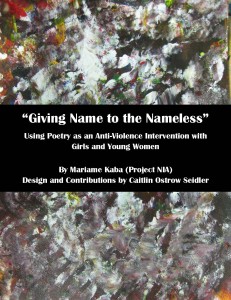Interrupting the Girl Prison Pipeline: “Giving Name to the Nameless”
Much of the discussion about the cradle to prison pipeline focuses on the plight of young men of color (particularly black boys). This is understandable given the dire statistics that illustrate how susceptible they are to future incarceration. The most often cited statistic is that 1 out of 3 black boys born in 2001 is likely to spend part of his life in prison. One of the pipelines to prison for young people are schools that push them out through harsh disciplinary policies, high stakes testing and other oppressive practices. I have blogged about this often.
However young women are also impacted by the cradle to prison pipeline. Their trajectory is different but exists nonetheless. Incarcerated girls are often victims of sexual and physical abuse in their early lives, and this is often neither recognized nor identified by school officials or other adults.
Sociologist Beth Richie has made the case that a key to understanding and responding to women as offenders is understanding their status as crime victims[1]. Laurie Schaffner (2007) extends this argument by suggesting that “young women adjudicated delinquent in juvenile court report suffering inordinate amounts of emotional, physical, and sexual trauma in early childhood and adolescence.”[2] She contends that “a disproportionate number of girls come into the juvenile justice system with family histories of physical and sexual violence and emotional neglect” (p.1229).
Many of the problems that young women face that relate to school failure and potential future incarceration stem from physical and sexual abuse. This has led some to characterize it as a “Girl Prison Pipeline.” In order to interrupt the girl prison pipeline then, particular attention must be paid to the physical and sexual abuse histories of young women.
For the past 15 years, I have worked with young women in a number of capacities. A lot of this work has focused on addressing the impact of gender-based violence in their lives. I have been asked by a number of friends and colleagues repeatedly over the years to share some of the resources that I use to discuss these sensitive issues with young women.
 In the last year, I decided to develop a curriculum resource that I could share with other educators, organizers, and counselors who are supporting young women to process the gender-based violence that they experience in their lives. The result is a new resource that I am releasing today. It is called “Giving Name to the Nameless: Using Poetry as an Anti-Violence Intervention with Girls.” I was lucky to collaborate on this again with my friend Caitlin Ostrow-Seidler who is a terrific educator and inspiring artist.
In the last year, I decided to develop a curriculum resource that I could share with other educators, organizers, and counselors who are supporting young women to process the gender-based violence that they experience in their lives. The result is a new resource that I am releasing today. It is called “Giving Name to the Nameless: Using Poetry as an Anti-Violence Intervention with Girls.” I was lucky to collaborate on this again with my friend Caitlin Ostrow-Seidler who is a terrific educator and inspiring artist.
For more information about how to access a PDF copy of the resource at no cost or to order a hard copy at a low-cost, CLICK HERE.
[1] Research on Women and Girls in the Justice System: Plenary Papers of the 1999 Conference on Criminal Justice Research and Evaluation – Enhancing Policy and Practice through Research, Volume 3. (September 2000). Office of Justice Programs. NCJ 180973.
[2] Schaffner, Laurie. 2007. Violence Against Girls Provokes Girls’ Violence: From Private Injury to Public Harm. Violence against Women, volume 13 no. 12. Pp.1229-1248.
